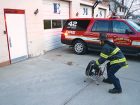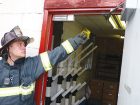
Features
Structural
Training
Tim-Bits: January 2015
I recently had the opportunity to teach a class on ventilation for a fire department that has a lot of large, low-rise apartment buildings in its district. Most of the buildings house low-income and/or elderly tenants, and the department frequently responds to smoke-removal calls from burned food. The fire chief wanted several young members in the department to hone their skills on positive-pressure ventilation (PPV) – a tactic they frequently use to remove smoke from these buildings.
January 6, 2015
By Tim Llewellyn
A common misconception with PPV is that once the fan is started, all of the bad air inside the entire structure will automatically find the opening and the smoke will flow outside. This is not necessarily true. PPV has the best results when firefighters follow a few easy steps.
The first step for successful PPV – besides checking to make sure the fan starts and runs, at least weekly – is to ensure the building is ready and capable of receiving positive pressure. The majority of the building’s windows and doors must be intact and closed. Positive pressure works by building pressure within the structure, and if the windows and doors are broken out or stuck open, PPV will not work as quickly or as intended.
The next few steps are easily accomplished by keeping four major points in mind: control of the ventilation inlet opening; control of the interior; control of the exhaust opening; and communication.
To control the ventilation opening, set up the fan at the main ventilation inlet point, usually an entry door. The general rule of fan placement is to set it somewhere between 1.8 to three metres (six to 10 feet) from the door to enable the cone of air produced by the fan to cover the door opening completely (see photo 1). This is not a hard and fast rule. A more reliable indicator of proper fan placement (in training) is to hold a piece of paper or a small strip of caution tape up to the top of the doorframe as soon as the fan is turned on. If the tape flows into the door, the cone of air is covering the door completely. If the tape hangs down or flows to the outside, the fan is too close and the cone of air is not covering the top of the door (see photo 2). If that is the case, move the fan backwards until the tape flows to the inside. This can also be accomplished at incident scenes by watching the smoke at the top of the door as soon as the fan is turned on.
The next step is controlling the interior. PPV is not a passive tactic; it requires firefighters on the inside wearing full PPE with SCBA on, waiting for the call to open and close windows and doors. A PPV fan takes a few minutes to build pressure within a structure; the bigger the structure, the longer it takes. The main concept behind controlling the interior is to ventilate one living space or room at a time by opening the door to a room and keeping all of the other doors closed.
Once the door to a room is open, the third and fourth steps – control of the exhaust opening, and communication – take place. Open the window and allow the positive pressure to force the smoke out. The interior window-and-door team needs to communicate with the incident commander on progress and location.
Once the smoke in a room is gone, the interior-team members should shut the window and then the door; they should wait a minute or so for the fan to once again build pressure in the structure before moving to the next room. The process of opening and closing doors and windows is then repeated for each room until the structure is free of smoke, or until it has been decreased to an acceptable level.
PPV is meant to be an active, sequential process – it is not just setting a fan in a door and letting it blow inside. Pull the fan off of your rig and practise with it. You will find that the use of PPV is a lot more than just blowing smoke.
A fire-service veteran since 1989, Tim Llewellyn is a firefighter for the Allegheny County Airport Authority in Pittsburgh, Penn. He volunteers for the Adams Area Fire District in Pennsylvania and is an instructor for the PA State Fire Academy, the Allegheny County Fire Academy and the Pittsburgh International Airport fire training facility. Email him at llewllyn.fire@gmail.com
Print this page

